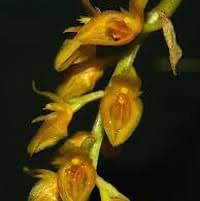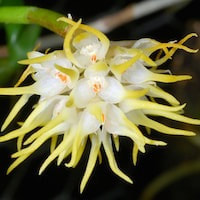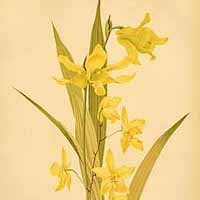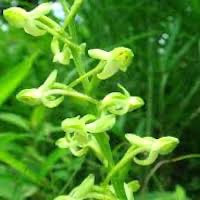MFR1- Men's Fresh 1 - Hay, Man!
|
Native Singaporean Orchid notes: Stanhopea Pulla
Stanhopea flowers have a very short lifespan of just three days, so they must quickly attract pollinators like male euglossine bees, such as Eulaema meriana. These bees collect and store the flower’s fragrances in their hind legs. The orchids mimic female bees and their pheromones to lure these pollinators. Stanhopea flowers have a delicate fragrance of lemon-lime candy, mint, and citrus, with a texture like plastic, and contain benzyl acetate, similar to jasmine.
|
Therapeutic Orchid notes:
|
Bulbophyllum sterile
Bulbophyllum nilgherrense, also known as Cirrhopetalum neilgherrense or B. rosemarianum, is an orchid species with potential health benefits. The leaf and pseudobulb extracts of a related species, Bulbophyllum sterile, have shown the ability to inhibit the growth of harmful bacteria like E. coli and Staphylococcus aureus. In the Valmikis tribe of India, the tubers of Bulbophyllum nilgherrense are eaten for their health benefits, highlighting the orchid’s potential uses. |
|
Bulbophyllum odoratissimum
Thazin hmwe, also known as Mihuashidou Lan in Chinese and Thazin hmwe in Myanmar, is an orchid found in China, Tibet, Nepal, Bhutan, Sikkim, Laos, Vietnam, Thailand, and Myanmar. It blooms from April to August in China and has a sweet fragrance. In traditional medicine, Thazin hmwe is used for fractures, pulmonary tuberculosis, and hernia pain through various herbal preparations. Its compounds, such as phenanthraquinone and bulbophyllanthrone, show potential anti-cancer activity. |
|
Ipsea speciosa Lindl.
The Daffodil orchid, known as Kiri Walla Kada and Naga-maru Ala in Sinhalese, is culturally significant for creating charms and love potions due to its believed aphrodisiac properties. However, it is a rare species facing extinction from overcollection. The name Naga-maru Ala means "the tuber that caused a sister's death," reflecting its powerful folklore. While its traditional uses are part of cultural practices, they lack scientific proof, making conservation efforts essential. |
|
Platanthera minor (Miq.) Rchb. f.
Platanthera minor, also known as Dayizhijian, Luanchunfendie Lan, Xiaoshechun Lan, and Guanyinzhun in Chinese, is an orchid that blooms in early summer in China, Korea, and Japan. In Traditional Chinese Medicine, it is used to strengthen the kidneys and lungs, treat conditions like weak bodies, asthma, and hernia, and improve overall health. A decoction made from 15-60 grams of the plant is used for these purposes. However, these uses are based on tradition and not widely studied, so consult a healthcare professional before use. |
Other scent note
Scentopia Library Reference ingredient
Cardamom - Sir Raffles Collection - Check details at Scentopia's scent library
Download the guided mediation that works best with this Orchid fragrance oil
| men_fresh_essential_oil_orchi_00001.mp3 | |
| File Size: | 115203 kb |
| File Type: | mp3 |




